AUDI S3 2009 Owners Manual
Manufacturer: AUDI, Model Year: 2009, Model line: S3, Model: AUDI S3 2009Pages: 324, PDF Size: 76.02 MB
Page 191 of 324

_______________________________________________ C_h _ i_ld _ S_ a_ f_ e_ t..,:c y __ JIIII
- Guide the upper tether strap under the rear head
restraint ~
page 188, fig. 162 (raise the head restraint if
necessary).
- Tilt the recess flap-detail view-~
page 188, fig. 162 up to
expose the anchor bracket.
- Slide the tether strap hook over the anchor bracket.
- Pull on the tether strap hook so that the spring catch of
the hook engages.
- Tighten the tether strap firmly following the child
restraint manufacturer's instructions.
Releasing the tether strap
- Loosen the tension following the child restraint manufac
turer's instructions.
-Depress the spring catch on the hook and release it from
the tether anchor .
& WARNING
Always read and heed all WARNINGS .
0 Note
If you leave the child restraint with the tether strap firmly installed
for several days, this could leave a mark on the upholstery on the
seat cushion and backrest in the area where the tether strap was
installed. The upholstery would also be permanently stretched
around the tether strap . This applies especially to leather seats .•
Controls and equip
ment Safety first Vehicle operation
Vehicle care Do-it-yourself service Technical data
Page 192 of 324

_1--_l_ n _t _ e _ll _,ig ,_,_ e_n _t _ t_ e_ c_ h_n _o_ l_ o ~g""- y.e- __________________________________________ _
Intelligent technology
Notice about data recorded by
vehicle control modules
Your vehicle is not equipped with an Event Data Recorder (EDR),
installed by some manufacturers for the express purpose of
capturing data for retrieval after an accident or crash event . EDR's
are sometimes called "crash recorders".
Some state laws restrict the retrieval or downloading of data stored
by EDR's that were insta lled in a vehicle for the express purpose of
retrieving data after an accident or crash event without the owner's
consent .
Although your vehicle is not equipped with an EDR, it is equipped
with a number of electronic control modules for various vehicle systems such as, for example, eng ine function, emission control, as
well as for the airbags and safety belts.
These electronic control modules also record vehic le -related data
during norma l vehicle operation for diagnostic and repair purposes .
The recording capacity of the electronic cont rol modules is limited
to data (no sound is recorded) and only a small amount of data is
actually recorded over a very limited period of time and stored when
a system fault or other condition is sensed by a control unit . Some
of the data then stored may relate to vehic le speed, direction,
braking as we ll as restraint system use and performance in the
event of a crash or other condition. Stored data can only be read and
downloaded with special equip men t.
Electronic Stabilization Program (ESP)
General
The Electronic Stabili ty Program increases driving
stability.
co ::,
_1, _ __ J"u. __ 11 ... _ ,.....u.,___,lli u.. _ .x,u _ _, r-u ~~ ~!' js:..~&c:',I
I
'
1 J
F ig . 16 3 Ce nte r
cons ole with E SP
sw itch
With ESP, control over the veh ic le is increased in situations when
the vehicle is close to the limits of grip, such as during acce leration
and in curves. ESP reduces the risk of skidding a nd improves vehicle
stability under all road conditions . It operates at all speeds .
The Anti-Lock Brake System (ABS), E lec tronic Differentia l Lock (EDS)
and Anti-Slip Regulation System (ASR) are integrated in the Elec
tronic Stability Program .
How ESP work s
The ESP control unit processes the fo llowing data from high-sensi
tive sensors : the rotational speed of the vehicle about its vertica l
axis, fore -and -aft and lateral acceleration forces, brake pressure and
steering angle.
Using steering ang le and vehicle speed, the direction the driver
wishes to travel is determined and continuously compared with
t,.
Page 193 of 324

actual vehicle behavior. If the two do not match, for example when
th e vehicle begins to skid, ESP brakes the appropriate wheel auto
matical ly .
The vehicle is stabilized again by the forces acting on the wheel
during braking. With an oversteering vehicle (tendency for the rear
end to skid out of the curve), the brake application is mainly at the
front wheel on the outside of the curve, with an
understeering
vehicle (tendency to run wide in the curve) at the rear wheel on the
inside of the curve or additionally at the other wheels as needed.
This brake application is accompanied by noises.
ESP works in conjunction with ABS=>
page 194. If there is malfunc
tion in the ABS, ESP is also inoperative.
Activating
The ESP is automatica lly activated when the engine is started, and
it performs a self-test. As soon as the test is completed, the system
is in normal operating mode. With ASR deactivated, or with ESP/ASR
deactivated, pressing the button=>
page 190, fig. 163 returns the
system to normal operation.
Deactivating
ESP should normally be activated at all times because this ensures
optimum vehicle stability. Only in certain exceptional cases it does
make sense to deactivate Anti-Slip Regulation (ASR) or the Elec
tronic Stability Program (ESP) by pressing the button =>
page 190,
fig. 163. Both deactivation stages can only be activated from normal
mode .
Deactivating ASR
Tap the switch . Deactivation is indicated by slow flashing of the ESP
lamp in the instrument cluster. In certain situations (e .g. driving
with snow chains, in deep snow or on loose ground, or when
rocking the car free), it may be necessary to deactivate ASR.
Deactivating ESP/ASR
Press the button for more than 3 seconds. Deactivation is indicated
by the ESP lamp in the ins trument cluster staying on permanently .
Controls and equip
ment Safety first Vehicle operation
Intelligent technology
This
deactivates the Electronic Stability Program (ESP) in addition to
ASR. No Elec tronic Stability System operation and no Anti -Slip
Regulation is available across the entire speed range; ASR and ESP
are activated only when the brakes are used for the duration of the
braking action and remain active until a stable vehicle condition has
been reached. There is no driving situation which requires ESP to be
deactivated, so this should only be done if the driver's skill and the
traffic situation permit.
& WARNING
• The limits of physics cannot be suspended by ESP. Even in vehi
cles with ESP. you should always adapt your driving to road and
traffic conditions. This is particularly true on a slippery and wet
road . Do not be tempted by the increased safety provided to take
risks -danger of an accident!
• Please note that when ASR or ESP /ASR is deactivated , the drive
wheels can spin on icy and slippery roads and the vehicle can
break away -danger of skidding!
[ i ] Tips
In the event of a defect in Audi magnetic ride, it can happen that
ASR and ASR/ESP cannot be deactivated, or they are activated auto
matically in the deactivated state.
Electronic differential lock (EDL)
The electronic differential lock monitors the rotational
speed of the drive wheels.
General notes
The electronic differential lock (EDU helps the car to start moving,
accelerate and c limb a gradient on surfaces providing poor or
a lmost no grip . Without EDL , this would be difficult, if not impos
sib le.
Vehicle care Do-it-yourself service Technical data
Page 194 of 324
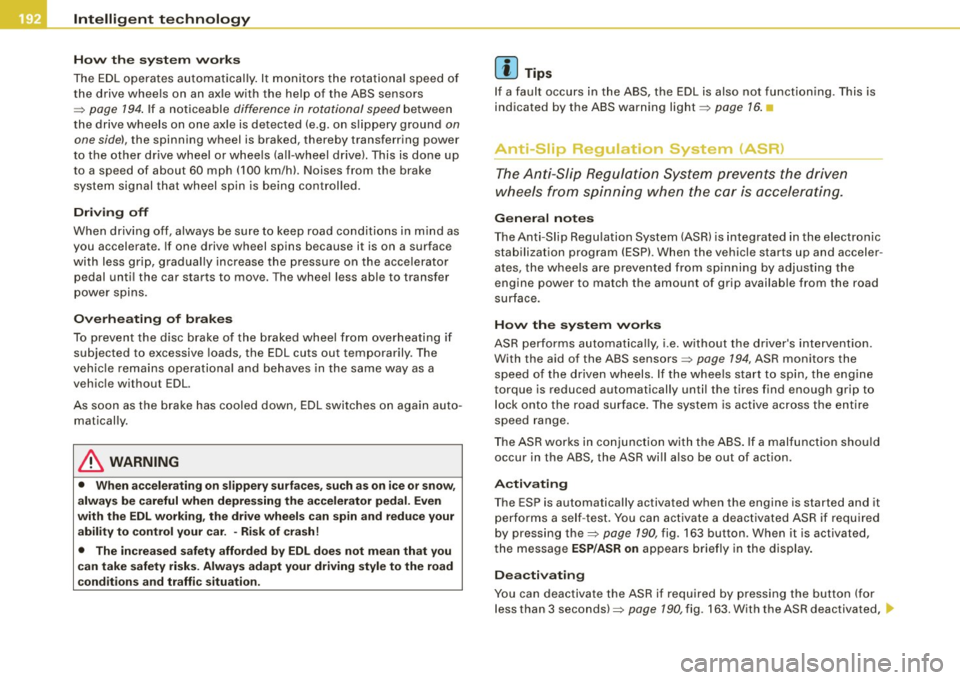
___ ln_ t _e_ ll-'"ig ...,_ e_ n_t _t_ e_ c_ h _ n_o _ l_o _,.g= y,_ __________________________________________ _
How the system works
The EDL operates automatically. It monitors the rotational speed of
the drive wheels on an axle with the help of the ABS sensors
=:,
page 194. If a noticeable difference in rotational speed between
the drive wheels on one axle is detected (e.g. on slippery ground
on
one side),
the spinning wheel is braked, thereby transferring power
to the other drive wheel or wheels (all-wheel drivel. This is done up
to a speed of about 60 mph (100 km/h). Noises from the brake
system signal that wheel spin is being controlled.
Driving off
When driving off, always be sure to keep road conditions in mind as
you accelerate. If one drive wheel spins because it is on a surface
with less grip, gradually increase the pressure on the accelerator
pedal until the car starts to move. The wheel less able to transfer
power spins.
Overheating of brakes
To prevent the disc brake of the braked wheel from overheating if
subjected to excessive loads, the EDL cuts out temporarily . The
vehicle remains operational and behaves in the same way as a
vehicle without EDL.
As soon as the brake has cooled down, EDL switches on again auto
matically.
& WARNING
• When accelerating on slippery surfaces, such as on ice or snow,
always be careful when depressing the accelerator pedal. Even
with the EDL working, the drive wheels can spin and reduce your ability to control your car. -Risk of crash!
• The increased safety afforded by EDL does not mean that you
can take safety risks. Always adapt your driving style to the road
conditions and traffic situation.
[ i] Tips
If a fault occurs in the ABS, the EDL is also not functioning . This is
indicated by the ABS warning light=:,
page 16. •
Anti-Slip Regulation System (ASR)
The Anti-Slip Regulation System prevents the driven
wheels from spinning when the car is accelerating.
General notes
The Anti-Slip Regulation System (ASR) is integrated in the electronic
stabilization program (ESP). When the vehicle starts up and acceler
ates, the wheels are prevented from spinning by adjusting the
engine power to match the amount of grip available from the road
surface.
How the system works
ASR performs automatically, i.e. without the driver's intervention.
With the aid of the ABS sensors=:,
page 194, ASR monitors the
speed of the driven wheels. If the wheels start to spin, the engine
torque is reduced automatically until the tires find enough grip to
lock onto the road surface. The system is active across the entire
speed range.
The ASR works in conjunction with the ABS. If a malfunction should
occur in the ABS, the ASR will also be out of action .
Activating
The ESP is automatically activated when the engine is started and it
performs a self -test . You can activate a deactivated ASR if required
by pressing the =:,
page 190, fig. 163 button . When it is activated,
the message
ESP/ASR on appears briefly in the display.
Deactivating
You can deactivate the ASR if required by pressing the button (for
less than 3 seconds)=:,
page 190, fig . 163. With the ASR deactivated, .,
Page 195 of 324
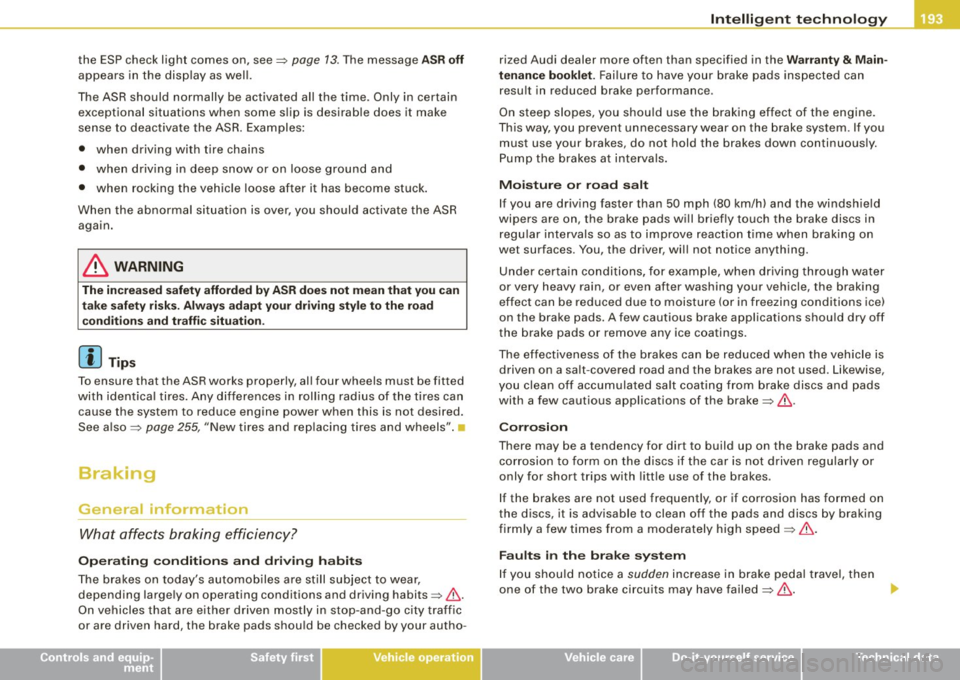
•
the ESP check light comes on, see~ page 13. The message ASR off
appears in the display as well.
The ASR should normally be activated all the time . Only in certain
exceptional situations when some slip is desirable does it make
sense to deactivate the ASR. Examples:
• when driving with tire chains
• when driving in deep snow or on loose ground and
• when rocking the vehicle loose after it has become stuck.
When the abnormal situation is over, you should activate the ASR
again.
& WARNING
The increased safety afforded by ASR does not mean that you can
take safety risks. Always adapt your driving style to the road
conditions and traffic situation.
[ i] Tips
To ensure that the ASR works properly, all four wheels must be fitted
with identical tires. Any differences in rolling radius of the tires can
cause the system to reduce engine power when this is not desired.
See also ~
page 255, "New tires and replacing tires and wheels". •
Braking
General information
What affects braking efficiency?
Operating conditions and driving habits
The brakes on today's automobiles are still subject to wear,
depending largely on operating conditions and driving habits~& .
On vehicles that are either driven mostly in stop-and-go city traffic
or are driven hard, the brake pads should be checked by your autho-
Intelligent technology
rized Audi dealer more often than specified in the Warranty & Main
tenance booklet.
Failure to have your brake pads inspected can
result in reduced brake performance.
On steep slopes, you should use the braking effect of the engine.
This way, you prevent unnecessary wear on the brake system. If you
must use your brakes, do not hold the brakes down continuously.
Pump the brakes at intervals.
Moisture or road salt
If you are driving faster than 50 mph (80 km/h) and the windshield
wipers are on, the brake pads will briefly touch the brake discs in
regular intervals so as to improve reaction time when braking on
wet surfaces. You, the driver, will not notice anything.
Under certain conditions, for example, when driving through water
or very heavy rain, or even after washing your vehicle, the braking
effect can be reduced due to moisture (or in freezing conditions ice)
on the brake pads. A few cautious brake applications should dry off
the brake pads or remove any ice coatings.
The effectiveness of the brakes can be reduced when the vehicle is
driven on a salt-covered road and the brakes are not used . Likewise,
you clean off accumulated salt coating from brake discs and pads
with a few cautious applications of the brake~&.
Corrosion
There may be a tendency for dirt to build up on the brake pads and
corrosion to form on the discs if the car is not driven regularly or
only for short trips with little use of the brakes .
If the brakes are not used frequently, or if corrosion has formed on
the discs, it is advisable to clean off the pads and discs by braking
firmly a few times from a moderately high speed~& .
Faults in the brake system
If you should notice a sudden increase in brake pedal travel, then
one of the two brake circuits may have failed~&. ..,
I t •
Page 196 of 324
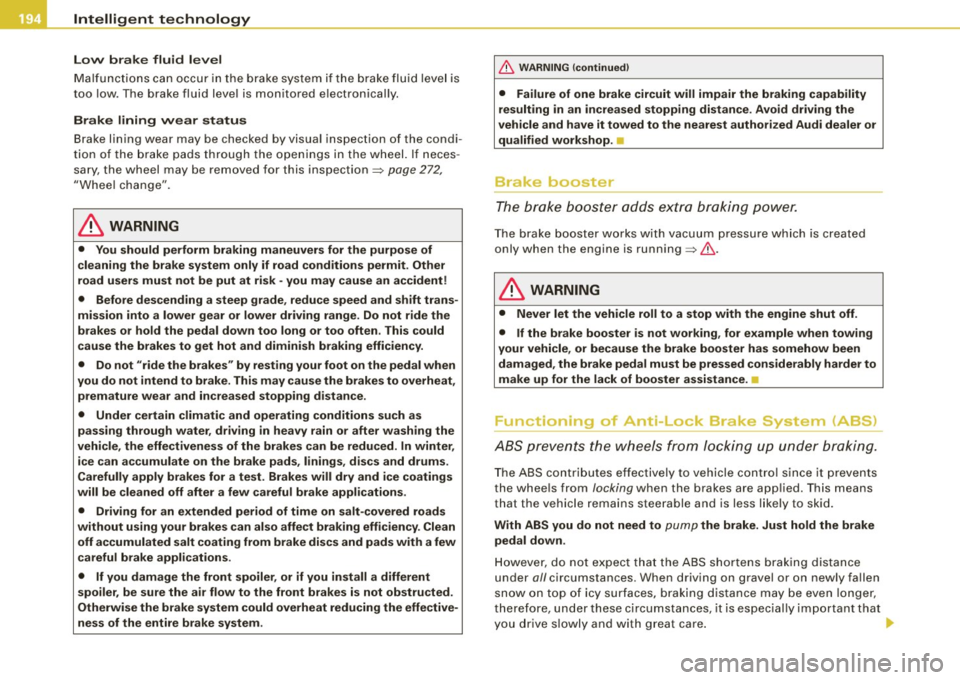
___ ln_ t _e_ ll-'"ig ...,_ e_ n_t _t_ e_ c_ h _ n_o _ l_o _,.g= y,_ __________________________________________ _
Low brake fluid level
Ma lfu ncti ons can occ ur in th e brake system if the bra ke flu id leve l is
too low. The brake fluid leve l is monitored e lectronically.
Brake lining wear status Bra ke lining wear may be checked by visual inspection of the condi
t ion of the brake pa ds through the o pen in g s in t he wheel. If neces
sary, the wheel may be removed for this inspection=>
page 272 ,
"Whee l change".
& WARNING
• You should perform braking maneuver s for the purpose of
cleaning the brake system only if road cond itions permit . Other
road u sers must not be put at risk -you may cause an accident !
• Before des cending a steep grade , reduce speed and shift trans
mission into a lower gear or lower driving range. Do not ride the
brake s or hold the pedal down too long or too often . This could
c ause the brakes to get hot and diminish braking efficiency.
• Do not "ride the brakes " by resting your foot on the pedal when
you do not intend to brake. This may cause the brakes to overheat, p rem ature wear and in creased stopping distance .
• Under certain climatic and operating conditions such as
passing through water , driv ing in heavy rain or after washing the
vehicle , the effectiveness of the brakes can be reduced. In winter ,
ice can accumulate on the brake pads , linings , discs and drums.
Carefully apply brakes for a test. Brakes will dry and ice coatings
will be cleaned off afte r a few careful b rake appli cations .
• Driving for an extended period of time on salt -covered roads
without using your brakes can also affe ct braking effic ien cy. Clean
off accumulated salt coating from brake discs and pads with a few
careful brake applications .
• If you damage the front spoiler , or if you install a different
spoiler , be sure the air flow to the front brakes is not obstru cted .
Otherwise the brake system could overheat reducing the effe ctive
ness of the entire brake system .
& WARNING (continued )
• Failure of one brake circuit will impair the braking capability
resulting in an increased stopping distance . Avoid driv ing the
vehicle and have it towed to the nearest authorized Audi dealer or
qu alified workshop. •
Brake booster
The bra ke boos ter adds e xtra bra king pow er.
Th e brake boost er wo rks wit h vacuum p ressu re wh ich is created
only when the engine is running=>& .
& WARNING
• Never let the vehicle roll to a stop with the engine shut off.
• If the brake booster is not working , for e xample when towing
your vehicle, or because the brake booster has somehow been damaged , the brake pedal must be pressed considerably harder to
make up for the lack of booster assistance . •
Functioning of Anti-Lock Brake System (ABS}
A BS p revents t he wheels from lockin g up unde r braking.
The ABS co ntrib utes effectively to ve hic le c ont ro l since it preven ts
the whee ls from
locking when the bra kes are app lied. Th is means
that the vehicle remains stee rable and is less l ikely to skid .
With ABS you do not need to
pump the brake. Just hold the brake
pedal down .
Ho wever , do not e xpect that t he ABS shor tens brak ing distance
under
all circumstances . When driv ing on gravel or on newly fa llen
snow on top of icy surfaces, b raki ng d istance may be even longer,
th ere for e, u nder these circumstances, it is esp ecially important t hat
you drive s lowly and w ith g reat ca re . ._
Page 197 of 324

How the ABS system works
An aut omatic check is made whe n a speed of ab out 4 mph (6 km/h)
is reached. When this happens, a pumping noise can be heard.
I f an individua l wheel begins to rotate too slowly in relation to
ve hicle speed and ten ds to lock, the A BS automatical ly reduces
brake pressure to prevent that wheel from locking.
T his auto matic adjust ment p rocess wil l cause a
slight vibration o f
the brake peda l and some noises to alert you that veh ic le speed
must be ada pted to e xisting roa d and traff ic c onditions.
& WARNING
Although the ABS is very effective , always remember that braking
c apability is limited by tire tra ction . Always adjust your driving
speed according to the road and traffic conditions. Do not let the
extra safety afforded by the ABS tempt you into taking e xtra risks .
The ABS cannot overcome the laws of physics.
[ i ) Tips
• I f ABS is not functioning properly, a warning light wil l come on.
See
=> page 16.
• I f a fau lt occurs in the ABS, the E DL is als o not fu ncti onin g. This
is indicated by the ABS warning light. •
Brake assistant
The brake a ssi st ant is de sig ned to a chieve th e opti mum
b ra kin g eff ec t.
The brake assistant helps to increase the effective braking power
and thus to ac hieve a s horte r stop ping dis tance. If the drive r
presses the brake pedal very quick ly, the brake assistant automati
ca lly b oosts the braki ng force to the maximu m level, up to th e point
where the anti -loc k brake function (A BS) intervenes to stop the
whee ls from loc king. You should then keep the brake pedal pressed
Controls and equip
ment Safety first Vehicle operation
Intelligent technology
until
the vehicle has braked to the required speed . The brake assis
t an t swi tc h es itse lf o ff as s oon as you r eleas e the b rake pe dal.
The brake assistant wi ll not be operative if there is a malfunction in
the ABS .
& WARNING
Please remember that the accident risk always increases if you
drive too fast , espe cially in corners or on a slippery road , or if you
follow the vehicle ahead of you too closely . An increased accident
risk cannot be compensated even by the brake assistant , so
always maintain a safe speed. •
ciectro-mechanical power assist
Th e e le ctr o-me ch anic al pow er assis t helps the driv e r
w hen steerin g.
The degree of powe r ass ist is electronically matched to veh icle
speed .
The power steering system assists the driver so that he can steer the
ve hicle with re d uced p hysi ca l eff ort.
Power steering w ill not work if the eng ine is off . As a result, the
stee ring whee l wi ll be ha rd to turn .
& WARNING
If the system develops a problem , you must seek qualified profe s
sional assistance .
0 Note
If there is an electronic ma lfunction, servotronic will still function
like a conventi onal power s teer ing sy stem , pr ovi din g a constant
steerin g support force that is no longer proportionate to the vehicle
Vehicle care Do-it-yourself service Technical data
Page 198 of 324
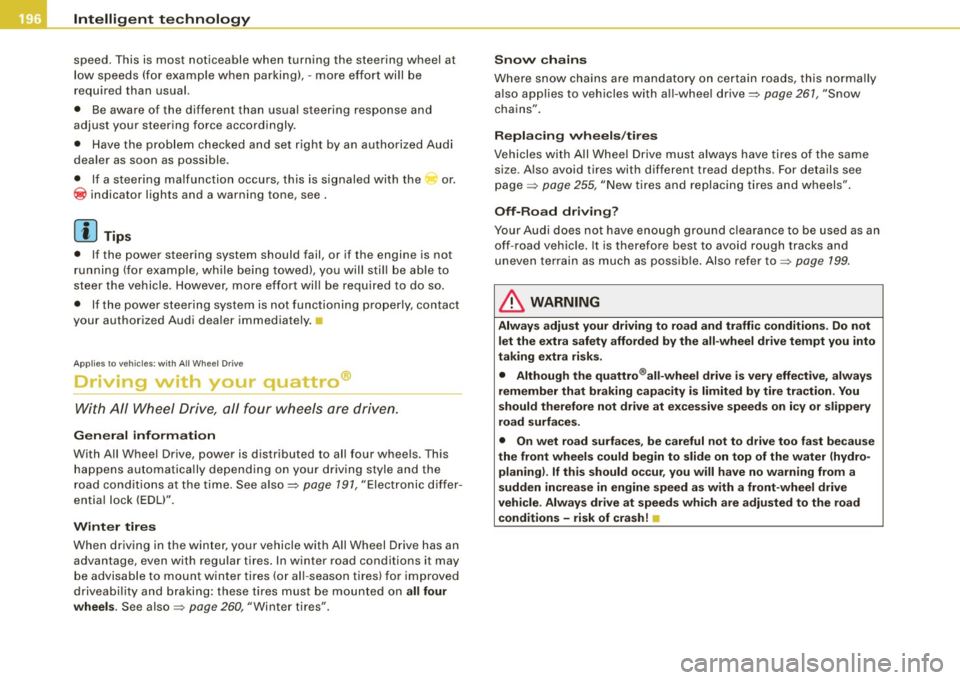
__ _:_:ln..:..t::.: e::.: l~ li :.;:g t:e::..: n..:.. t:...::. te::::..:: c~h :.:.n .:..: o:::.: l:.: o :.;g~ yL- ________________________________________ _
speed. This is most noticeable when turning the steering wheel at
low speeds (for example when parking), -more effort will be
required than usual.
• Be aware of the different than usual steering response and
adjust your steering force accordingly.
• Have the problem checked and set right by an authorized Audi
dealer as soon as possible.
• If a steering malfunction occurs, this is signaled with the or.
@ indicator lights and a warning tone, see.
[ i) Tips
• If the power steering system should fail, or if the engine is not
running (for example, while being towed), you will still be able to
steer the vehicle. However, more effort will be required to do so.
• If the power steering system is not functioning properly, contact
your authorized Audi dealer immediately.
Applies to vehicles: with All Wheel Drive
Driving with your quattro®
With All Wheel Drive, all four wheels are driven.
General information
With All Wheel Drive, power is distributed to all four wheels. This
happens automatically depending on your driving style and the
road conditions at the time. See also::::,
page 191, "Electronic differ
ential lock (EDU".
Winter tires
When driving in the winter, your vehicle with All Wheel Drive has an
advantage, even with regular tires. In winter road conditions it may
be advisable to mount winter tires (or all -season tires) for improved
driveability and braking: these tires must be mounted on
all four
wheels.
See also ::::, page 260, "Winter ti res".
Snow chains
Where snow chains are mandatory on certain roads, this normally
also applies to vehicles with all-wheel drive:::::,
page 261, "Snow
chains".
Replacing wheels/tires
Vehicles with All Wheel Drive must always have tires of the same
size. Also avoid tires with different tread depths. For details see
page ::::,
page 255, "New tires and replacing tires and wheels".
Off-Road driving?
Your Audi does not have enough ground clearance to be used as an
off-road vehicle. It is therefore best to avoid rough tracks and
uneven terrain as much as possible. Also refer to::::,
page 199.
& WARNING
Always adjust your driving to road and traffic conditions. Do not
let the extra safety afforded by the all-wheel drive tempt you into
taking extra risks.
• Although the quattro ®all-wheel drive is very effective, always
remember that braking capacity is limited by tire traction. You
should therefore not drive at excessive speeds on icy or slippery
road surfaces.
• On wet road surfaces, be careful not to drive too fast because
the front wheels could begin to slide on top of the water (hydro planing). If this should occur, you will have no warning from a
sudden increase in engine speed as with a front-wheel drive
vehicle. Always drive at speeds which are adjusted to the road
conditions -risk of crash!
n
Page 199 of 324
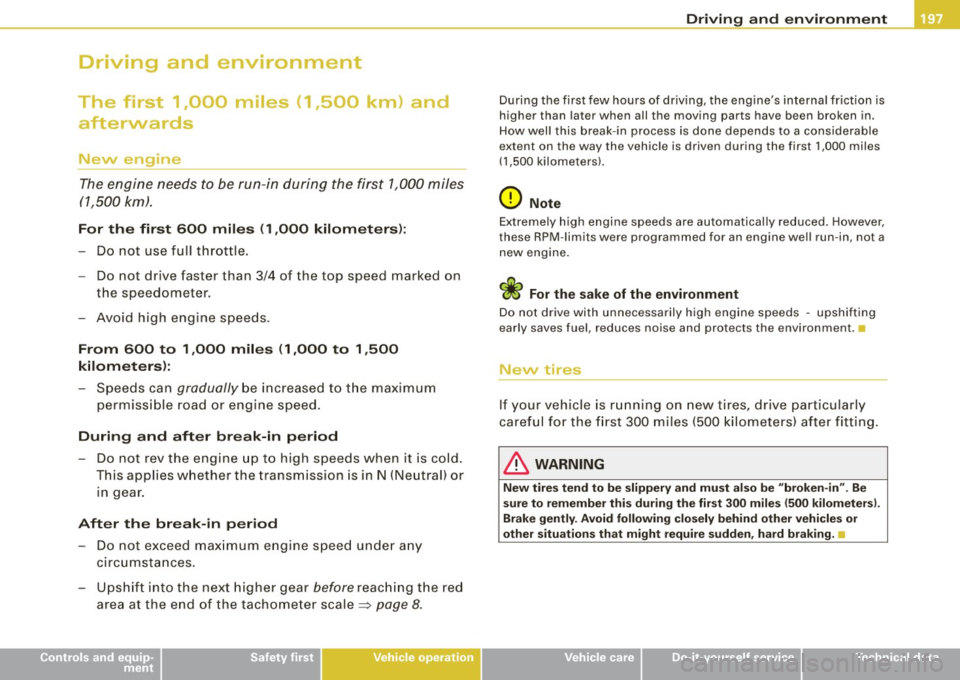
Driving and environment
The first 1,000 miles (1,500 km) and afterwards
!\Jew engine
The engine needs to be run-in during the first 1,000 miles
(1,500 km).
F o r th e fir st 600 mil es (1,000 kilomet ers):
Do not use full throttle.
- Do not drive faster than 3/4 of the top speed marked on
the speedometer.
- Avoid high engine speeds .
From 600 t o 1,000 mil es (1,000 t o 1,500
kil om eter s):
- Speeds can gradually be increased to t he maximum
permiss ible road or engine speed .
During and aft er br eak-in p eri od
- Do not rev the engine up to high speeds when it is cold. This applies whether the transm ission is in N (Neutral) or
1n gear.
Aft er the br eak-in p eriod
- D o not exceed max imum e ngine speed unde r any
circumstances.
- Upshift into the next higher gear before reaching the red
area at the end of the tachome ter scale
~ page 8 .
Controls and equip
ment Safety first Vehicle operation
Dri
ving and environm ent
During the first few hours of driving, the eng ine's internal friction is
higher than later when all the moving parts have been broken in.
How well this break -in process is done depends to a considerable
extent on the way the vehicle is driven during the first 1,000 miles
(1,500 ki lometers).
0 Not e
Extreme ly high engine speeds are automatically reduced. However,
these RPM -limits were programmed for an engine we ll run-in, not a
new engine .
~ For the sake of the environment
Do not drive with unnecessarily high engine speeds -upshifting
early saves fuel, reduces noise and protects the environment .
New tires
If your v ehic le is running on new tires, driv e particularly
carefu l for the first 300 miles (500 ki lometers) after fitting.
& WARNING
N ew tir es tend to be slipp ery and mu st al so be "brok en -in ". B e
su re to r ememb er thi s during th e fir st 300 m ile s ( 50 0 k ilome te rs).
Brak e gen tly. Av oid follow ing close ly behind other vehicl es or
o the r s ituati ons that mig ht requi re su dde n, ha rd b raking.•
Vehicle care Do-it-yourself service Technical data
Page 200 of 324
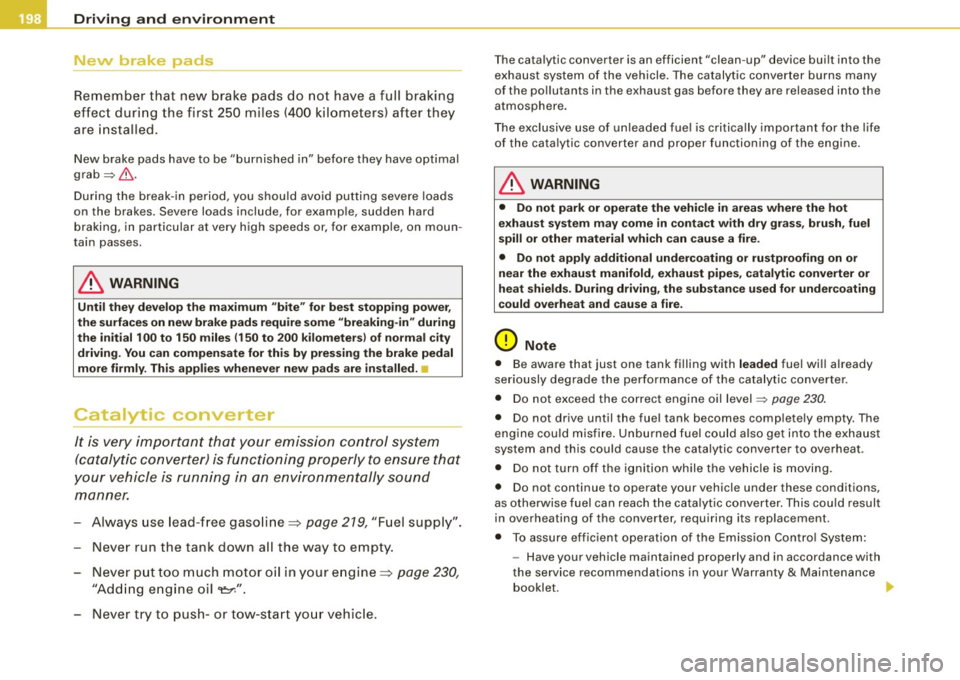
___ D_ r_iv _i _n-' g=- a _n_d_ e_ n_v _ i_r _o _n_ m_ e_ n_t _____________________________________________ _
New brake pads
--
Remember that new brake pads do not have a full braking
effect during the first 250 miles (400 kilometers) after they
are installed .
New brake pads have to be "burnished in" before they have optimal
grab =>& .
During the break -in period, you should avoid putting severe loads
on the brakes . Severe loads include, for examp le, sudden hard
braking, in particular at very high speeds or, for example, on moun
tain passes.
& WARNING
Until they develop the maximum "bite " for best stopping power,
the surfaces on new brake pads require some "breaking -in" during
the initial 100 to 150 miles (150 to 200 kilometers) of normal city
driving. You can compensate for this by pressing the brake pedal
more firmly . This applies whenever new pads are installed.•
Catalytic converter
It is very important that your emission control system
(catalytic converter) is functioning properly to ensure that
your vehicle is running in an environmentally sound
manner.
- Always use lead-free gasoline:=> page 219, "Fuel supply".
- Never run the tank down all the way to empty.
- Never put too much motor oil in your engine ==>
page 230,
"Adding engine oil 't=:;rl".
Never try to push- or tow-start your vehicle.
The catalytic converter is an efficient "clean-up" device built into the
exhaust system of the vehicle. The catalytic converter burns many
of the po llutants in the exhaust gas before they are released into the
atmosphere.
The exclusive use of unleaded fuel is critically important for the life
of the catalytic converter and proper functioning of the engine.
& WARNING
• Do not park or operate the vehicle in areas where the hot
exhaust system may come in contact with dry grass, brush, fuel
spill or other material which can cause a fire .
• Do not apply additional undercoating or rustproofing on or
near the exhaust manifold, exhaust pipes, catalytic converter or
heat shields. During driving, the substance used for undercoating
could overheat and cause a fire .
0 Note
• Be aware that just one tank filling with leaded fuel will alr eady
seriously degrade the performance of the catalytic converter.
• Do not exceed the correct engine oil level=>
page 230.
• Do not drive until the fuel tank becomes completely empty. The
engine could misfire. Unburned fuel could also get into the exhaust
system and this could cause the catalytic converter to overheat.
• Do not turn off the ignition while the vehicle is moving.
• Do not continue to operate your vehicle under these conditions,
as otherwise fuel can reach the catalytic converter. This could result
in overheating of the converter, requiring its replacement .
• To assure efficient operation of the Emission Control System:
- Have your vehicle maintained properly and in accordance with
the service recommendations in your Warranty
& Maintenance
booklet. •